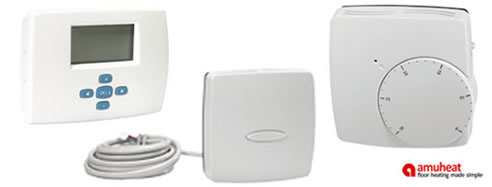Energy Saving Hydronic Underfloor Heating Controls from Amuheat The basis of any well-designed heating system is to provide an affordable and comfortable environment for the occupants, so it is worth thinking more along the lines of heating the occupants and not the building. Also, heating systems should have suitable controls to achieve comfort conditions and maintain economic operation. Traditional hydronic underfloor heating designs incorporate a single room thermostat which serves only as a high limit device in the room it is installed in with no consideration to other rooms throughout the home. Different rooms gain temperature for different reasons - for example from the solar gains in a south-facing lounge, or from the heat given off when there's cooking in the kitchen. Without a thermostat, the hydronic underfloor heating system cannot recognize the changes in these rooms and may continue to provide heat, leading to overheating. Hydronic underfloor heating is also different to normal heating in that it requires to be in operation continuously through winter as traditionally hydronic underfloor heating systems have relatively slow response times. Energy wastage occurs during no or low demand periods where the boiler is on at regular intervals to maintain the heat when the occupants do not need it. The result of poor heating control systems is that the customer is faced with huge heating bills. A better alternative would be to install modern thermostatic controls for inside the home, to monitor the internal conditions in each zone and thus regulate the temperature much more effectively. To further reduce running costs and to have realistic heat up and cool down response times, rather than the system being switched off, the temperature is reduced by about 4°C during the night or during periods when the home is unoccupied. This is called set back because the system is turned down not off. Set-back can be achieved in two ways.
Individual Programming
Centralised Programming Speedfit hydronic underfloor heating can operate with almost any type of heat source, including combination boilers, heat pumps and solar storage. The choice of controls depends on the system being installed, the building it is being installed in and the needs of the occupants.
|
Sydney: (02) 9114 6934 1/13 Brumby Street, Seven Hills NSW 2147
|
Sydney: (02) 9114 6934
Melbourne: (03) 9018 9552
ENQUIRE HERE



 Touch Screen Programmable Thermostats by
Touch Screen Programmable Thermostats by Hydronic Heating for Terracotta Tile
Hydronic Heating for Terracotta Tile Electric Under Carpet Floor Heating from
Electric Under Carpet Floor Heating from Hydronic Screed Under Tile Heating by
Hydronic Screed Under Tile Heating by Mirror Demister by Amuheat
Mirror Demister by Amuheat Electric Underfloor Heating Mats from
Electric Underfloor Heating Mats from Floating Floor Underfloor Heating
Floating Floor Underfloor Heating Radiant Underfloor Heating for Tiles &
Radiant Underfloor Heating for Tiles & Sustainable Radiant Heating Systems
Sustainable Radiant Heating Systems Energy Efficient Underfloor Heating
Energy Efficient Underfloor Heating Under Tile Heating Mats Available Online
Under Tile Heating Mats Available Online Efficient Under Carpet Floor Heating
Efficient Under Carpet Floor Heating Thin Floor Heating Under Tile &
Thin Floor Heating Under Tile & Under Tile Floor Heating Thin Cable Mat,
Under Tile Floor Heating Thin Cable Mat, Save Energy with Under Floor Heating,
Save Energy with Under Floor Heating, Energy Efficient Thin Under Tile Floor
Energy Efficient Thin Under Tile Floor Mirror Demisters from Amuheat
Mirror Demisters from Amuheat Unique Floor Heating Cable by Amuheat
Unique Floor Heating Cable by Amuheat Hydronic Underfloor Heating Speedfit
Hydronic Underfloor Heating Speedfit In Slab Cable Underfloor Heating System
In Slab Cable Underfloor Heating System
